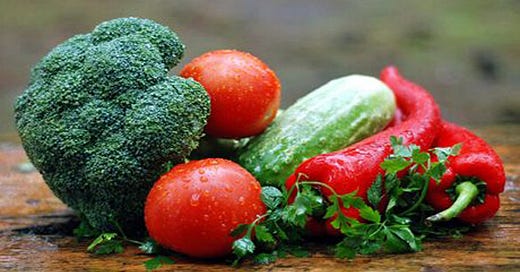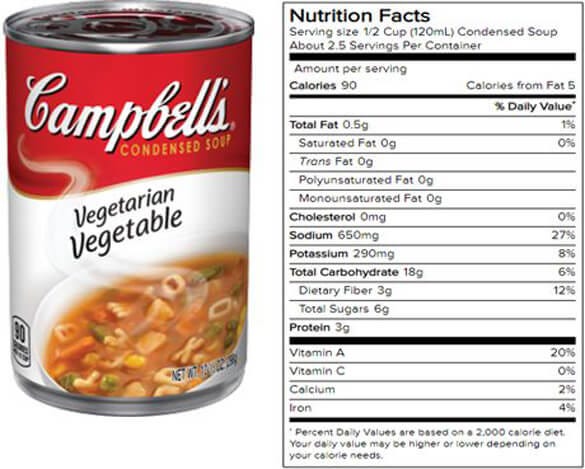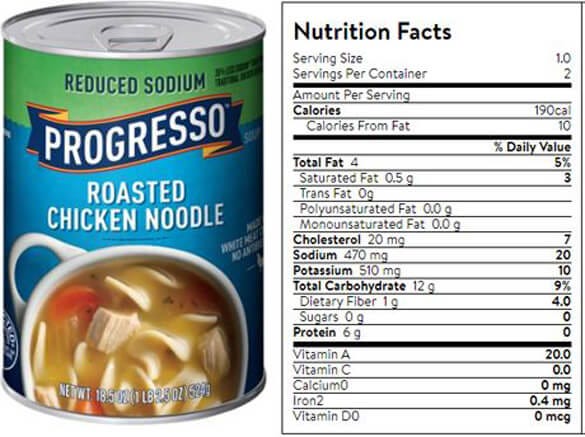Have you made the decision to try to eat a healthier diet? If so, I commend you.
After all, along with regular exercise, eating a healthy diet can help you ward off many serious health problems later in life (and fix some of the problems you might have right now).
But unfortunately, it can be pretty difficult to determine which foods are actually healthy with just a casual glance.
Here are several tips that can help:
Note: I'll be using sodium in most of the examples that follow because excess sodium contributes to so many health problems in the U.S.
However, the principles explained below also apply to other ingredients as well.
1 - Completely ignore any "healthy" claims that are printed on the front of a food container.
Simply put, everything you see on a food product's front label is nothing but marketing info. That's where they put the enticing teasers that are intended to draw your attention.
Instead of reading the front label, turn the package around and read the "Nutrition Facts" panel on the back.
Why? Because food manufacturers are allowed to print most anything they want on the front of the package, but federal law requires that the info contained on the Nutrition Facts panel be completely accurate.
For example, many items will claim to be "Heart Healthy" because they are low in fat and calories.
However, if you turn them around and read the Nutrition Facts panel you'll see that they're absolutely packed with sodium - which happens to be one of the worst ingredients a heart patient can consume!
2 - Pay special attention to the "Serving Size".
One huge mistake that many people make when reading a Nutrition Facts panel is believing that the quantities listed for the ingredients are for the entire package. Well, they aren't.
The listed quantities are per-serving, not per package!
As an example, here's the Nutrition Facts panel for a regular size can of Campbell's Vegetarian Vegetable soup:
If you look at the very top of the Nutrition Facts panel you'll see that this regular size can of soup actually contains 2.5 servings.
That means if you eat the entire can of soup you'll be receiving 2.5 times the amounts listed on the label. And of course most everyone who eats canned soup eats the entire can, right?
Put another way, this one can of soup contains a whopping 1,625mg of sodium. And in case you're wondering, that's 125mg more than the entire recommended daily allowance of 1,500mg!
In stark terms, if you eat this one can of soup you'll end up consuming more sodium than is recommended for an entire day!
(And that doesn't even include the sodium that's in any crackers or any other food item(s) that you might decide to eat with it.)
3 - Don't be fooled by the word "Reduced".
Grocery store shelves have lots of items that are touted as containing "Reduced Sodium", "Reduced Fat" or "Reduced Something Else".
The thing is, "Reduced" can be a far cry from "Low".
In order to qualify to use the term "Reduced" the manufacturer simply needs to lower the amount of the "reduced" ingredient by 25% compared to the amount that's normally included.
As an example, let's take a look at the Nutrition Facts panel for a can of Progresso Reduced Sodium Roasted Chicken Noodle Soup:
As you can see, this can of "Reduced Sodium" soup still contains a total of 940mg of sodium (remember, the can contains two servings).
That means if you eat this entire can of "Reduced Sodium" soup (and who wouldn't?) you'll end up consuming a huge portion of the sodium that's recommended for an entire day.
4 - What's "healthy" for one person might be horribly unhealthy for someone else.
As you probably know, folks with a history of heart problems are urged to eat the least amount of sodium possible while diabetes patients are encouraged to eat foods that are low in sugars and carbohydrates.
Well guess what? Many foods that are low in sodium (and thus often labeled "heart healthy") are absolutely loaded with sugars and/or carbs.
That makes it extremely difficult for someone who is dealing with both a heart issue and diabetes to find foods that are actually healthy for them.
That's why it's extremely important to always read a product's Nutrition Facts panel very carefully before you place it in your shopping cart!
5 - Always read a product's "Ingredients List".
Near the bottom of every Nutrition Facts panel is a list of all the ingredients contained within that product, and those ingredients are listed in order of quantity (most to least).
The ingredients that the product has the most of are listed first, which means if you see either sodium or any form of sugar listed near the top/front of the list that should raise a huge red flag.
6 - It's hard to go wrong by consuming fresh fruits and vegetables!
As you probably know, most fresh fruits and veggies are very low in sodium and they're absolutely packed with essential nutrients.
That's why doctors routinely recommend eating them as often as possible while trying to avoid less healthy "processed" foods.
Just be aware that some fruits and vegetables are high in carbohydrates and natural sugars, and that can be a problem if you have diabetes.
Bottom line: When shopping for "healthy" foods it's always best to ignore anything you see printed on the front of the package.
Carefully read the info provided on the Nutrition Facts panel on the back instead.
And always, always, always remember to take the item's serving size into consideration.
And finally, one more thing...
Did I mention that it's hard to go wrong by choosing fresh fruits and vegetables?
Like this post? If so, check out the archives for lots more.
Be sure to subscribe to receive a new post of inspiration in your email inbox every day.






